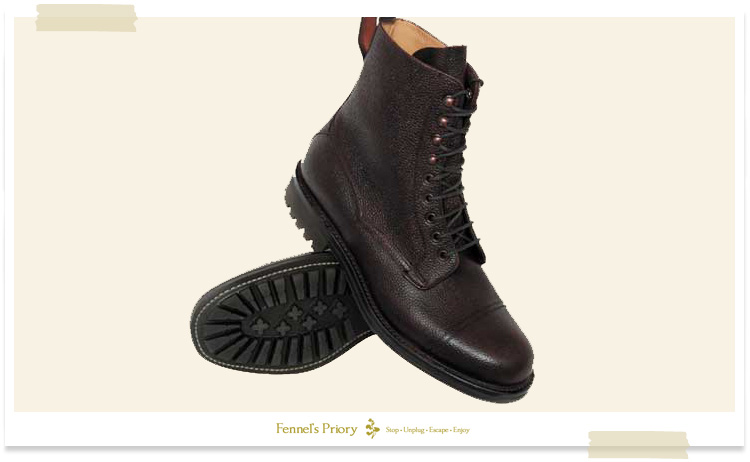
Country Clothing – Boots, Wellingtons and Shoes
Country boots
I like robust, durable, leather boots. Anything from study walking boots (the ones by Brasher and Berghaus seem to last the longest), to workman’s steel toe capped boots and high quality leather shooting boots. These are proper boots. Anything less will either fall apart or cripple my feet by the end of the day.
William Lennon in the English Peak District makes the very best traditional work boots, whilst the Glencarse and Rannoch boots by Hoggs of Fife are the best high quality boot.
Vibram soles are the best for walking boots, although a good commando sole is an excellent and traditional alternative.
Try to steer clear of boots where the stitching that attaches the sole to the upper is exposed. The stitching will quickly rot, especially if you get manure on the boots. (I once had a pair of super-comfortable Dr. Marten boots fall to pieces after wearing them to clean out a cattle shed on the farm.)
Boots must be as waterproof as possible. Modern Gore-Tex linings help this, but I find that regular applications of dubbing will seal the boot (up to the laces) and keep the leather soft.
Wellingtons
Some of my friends have Dubarry boots, which look very traditional and are a good alternative to rubber Wellingtons. However, I’m a fan of proper wellies. Le Chameau and Aigle are the best. The latter are supposed to be the ‘Rolls Royce’ option, but I wear Le Chameau because I find them most comfortable. I have a pair of Le Chameau Vizernord neoprene-lined wellies that I purchased in 1997 and which are still going strong. They were expensive, but have proven their value and are far more comfortable than a cheap pair of wellies. (Cheaper wellies tend to be too stiff around the calves, flap against one’s legs, have too much ‘give’ in the sole, or they might just rub one’s heel due to a poor fit. I’ve found, through trial and error, that it’s worth spending the money and getting a good pair of wellies.)
Country shoes
For me, there is only one type of country shoe – the brogue.
I like models with either full broguing (holes on and around the toe, punched into a second layer of leather) or partial broguing. I’m not a fan of leather-soled shoes. I once had a pair disintegrate during a monsoon-style rainstorm in the south of France. I had to turn up to a customer meeting with the soles of my shoes flapping around like pieces of wet chamois leather. Leather soled shoes may be light and very traditional, but they are best reserved for city boardrooms. They grip poorly and are useless in the wet. Traditional rubber-soled shoes get my vote, especially if the soles have a heavy ‘commando’ grip. These shoes can be worn for best occasions, whilst still being versatile enough to wear in the field. Glengarry, Barbour and Musto all make brogues with commando soles.
Criteria for selecting traditional footwear
Comfort
The boot or shoe should fit comfortably, not too loose as to rub and cause blisters.
Sturdiness
The sole must be sturdy. Too soft and it will give you foot-ache after a long walk. The leather should be relatively thick (especially in boots) so to stand knocks and scrapes.
Grip
A deep grip sole is important, otherwise you'll slip about on wet, loose or icy surfaces.
Waterproofed
Country footwear should be able to repel water from dewy grass, rain, puddles or shallow streams. If you footwear leaks, your feet will quickly blister.
Looks
Country boots and shoes should be brown. The exception is work boots, which may be black, and Wellingtons which usually are green. Remember: "Brown for the country; black for the town (and funerals)".
If you like this blog, then you might like Fine Things, Fennel's Journal No. 8
To stay updated with the work of lifestyle and countryside author Fennel Hudson, then please subscribe to Fennel on Friday. You'll receive a blog, video or podcast sent direct to your email inbox in time for the weekend.



